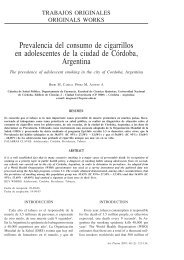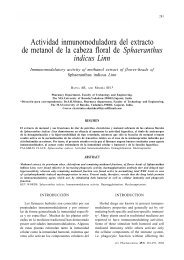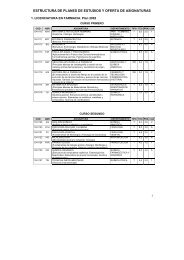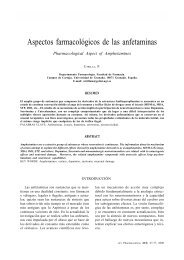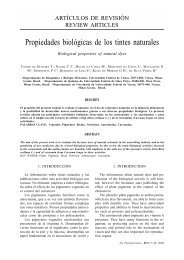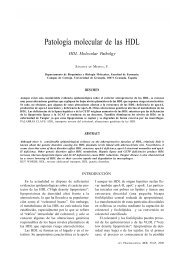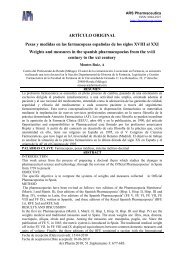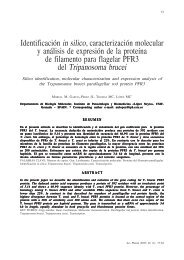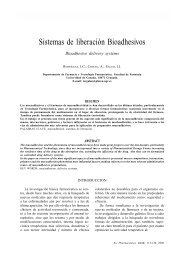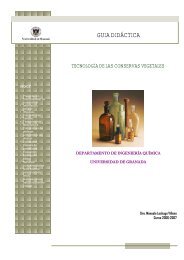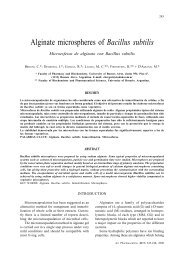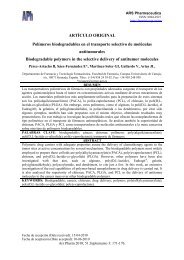Comparación de aceites esenciales de Matricaria recutita L. de ...
Comparación de aceites esenciales de Matricaria recutita L. de ...
Comparación de aceites esenciales de Matricaria recutita L. de ...
You also want an ePaper? Increase the reach of your titles
YUMPU automatically turns print PDFs into web optimized ePapers that Google loves.
COMPARACIÓN DE ACEITES ESENCIALES DE MATRICARIA RECUTITA L. DE ORIGEN DIVERSO<br />
<strong>Comparación</strong> <strong>de</strong> <strong>aceites</strong> <strong>esenciales</strong> <strong>de</strong><br />
<strong>Matricaria</strong> <strong>recutita</strong> L. <strong>de</strong> origen diverso<br />
Comparison of essential oil content of <strong>Matricaria</strong> <strong>recutita</strong> L.<br />
from different origins<br />
RAAL A, 1 ARAK E, 1 ORAV A, 2 IVASK K 2<br />
1 Departamento <strong>de</strong> Farmacia, Universidad <strong>de</strong> Tartu. c/ Jakobi 2, Tartu 51014, Estonia. E-mail: araal@ut.ee<br />
2 Instituto químico, Universidad Técnica <strong>de</strong> Tallinn. c/ Ehitajate tee 5, Tallinn 19086, Estonia.<br />
E-mail: aorav@argus.chemnet.ee<br />
Este trabajo ha sido financiado a través <strong>de</strong> la beca N o 4332 <strong>de</strong> la Fundación Científica <strong>de</strong> Estonia.<br />
This work has been supported by the Estonian Scientific Foundation Grant No. 4332.<br />
RESUMEN<br />
En el presente trabajo se han <strong>de</strong>terminado las variaciones en la composición <strong>de</strong> <strong>aceites</strong> <strong>esenciales</strong> <strong>de</strong> Chamomilla<br />
<strong>recutita</strong> (L.) Rauschert, especie cultivada en distintos países <strong>de</strong> Europa. Los <strong>aceites</strong> <strong>esenciales</strong> han sido extraídos <strong>de</strong><br />
las muestras secas, con unos rendimientos <strong>de</strong> 3.6–6.6 mg/g y en ellos se han i<strong>de</strong>ntificado 38 componentes, los cuales<br />
representan más <strong>de</strong>l 95% <strong>de</strong>l total <strong>de</strong>l aceite esencial. El principal compuesto biológicamente activo en el aceite<br />
esencial <strong>de</strong> la manzanilla proce<strong>de</strong>nte <strong>de</strong> Gran Bretaña fue el óxido <strong>de</strong> β-bisabolol (25%); en los proce<strong>de</strong>ntes <strong>de</strong><br />
Bélgica, Estonia y Francia predominaba el óxido <strong>de</strong> α-bisabolol (43–55%) y el compuesto principal en el <strong>de</strong> Hungría<br />
fue el α-bisabolol (24%). El (E)-β-farneseno se encontraba en sus mayores proporciones (5-7%) en los <strong>de</strong> Bélgica y<br />
Francia, mientras que el camazuleno representaba <strong>de</strong>l 1 al 14% <strong>de</strong>l total <strong>de</strong> los distintos <strong>aceites</strong> <strong>esenciales</strong> siendo más<br />
abundante en los <strong>aceites</strong> proce<strong>de</strong>ntes <strong>de</strong> Gran Bretaña (14%).<br />
PALABRAS CLAVES: α-bisabolol. Óxido <strong>de</strong> α-bisabolol. Óxido <strong>de</strong> β-bisabolol. Camazuleno. Chamomilla <strong>recutita</strong>. Cis-enin-dicicloéter.<br />
(E)-β-farneseno. Aceites <strong>esenciales</strong>. Manzanilla alemana. Manzanilla silvestre. <strong>Matricaria</strong> <strong>recutita</strong>. Camomila.<br />
ABSTRACT<br />
Variations in the essential oil content of <strong>Matricaria</strong> <strong>recutita</strong> L., cultivated in different European countries, were <strong>de</strong>termined.<br />
The oil was obtained in yields of 3.6-6.6 mg/g from dried samples. 38 components were i<strong>de</strong>ntified, representing over 95%<br />
of the total yield of oil. The principal biologically active compound in chamomile oil, of British origin, was bisabolol<br />
oxi<strong>de</strong> B (25%). In oils from Belgium, Estonia and France, bisabolol oxi<strong>de</strong> A (43-55%) was predominant, whereas in<br />
Hungarian oil the main compound was alpha-bisabolol (24%). (E)-beta-Farnesene content was predominant (5–7%) in<br />
oils from Belgium and France. Chamazulene was present in 1–14% of oils and its content was highest in oil of British<br />
origin (14%).<br />
KEYWORD: <strong>Matricaria</strong> <strong>recutita</strong> L. Compositae. German chamomile. Essential oil composition. Bisabolol oxi<strong>de</strong> A and B.<br />
Alpha-bisabolol. Cis-enyne-dicycloether. Chamazulene. (E)-beta-farnesene.<br />
INTRODUCCIÓN<br />
La manzanilla alemana (<strong>Matricaria</strong> <strong>recutita</strong><br />
L., Chamomilla <strong>recutita</strong> (L.) Rauschert) es una<br />
planta herbácea medicinal que se cultiva en todo<br />
el mundo. Su aceite esencial (AE) se utiliza con<br />
relativa frecuencia en las industrias farmacéuti-<br />
INTRODUCTION<br />
159<br />
Wild chamomile (<strong>Matricaria</strong> <strong>recutita</strong> L.,<br />
Chamomilla <strong>recutita</strong> (L.) Rauschert) is cultivated<br />
all over the world as a herbaceous medicinal<br />
plant. Its essential oil is used rather wi<strong>de</strong>ly in<br />
the pharmaceutical, cosmetic, and food indus-<br />
Ars Pharmaceutica, 44:2; 159-165, 2003
160<br />
cas, cosméticas y alimentarias. Hasta el momento<br />
presente, la composición <strong>de</strong>l aceite esencial<br />
<strong>de</strong> la manzanilla ha sido el objeto <strong>de</strong> un reducido<br />
número <strong>de</strong> investigaciones. 1–9 Los principales<br />
compuestos biológicamente activos <strong>de</strong>l AE <strong>de</strong><br />
manzanilla son: óxidos <strong>de</strong> bisabolol, óxido <strong>de</strong><br />
bisabolona, α-bisabolol, espatulenol, en-in-dicicloéter<br />
y camazuleno. En la manzanilla estudiada<br />
se encuentran <strong>de</strong>terminados componentes<br />
antiinflamatorios y antiespasmódicos <strong>de</strong> entre los<br />
cuales los más importantes son <strong>de</strong>rivados terpénicos:<br />
matricina, camazuleno, α-bisabolol y los<br />
óxidos α y β <strong>de</strong>l α-bisabolol. 10 Se han <strong>de</strong>mostrado<br />
las acciones antiflogísticas <strong>de</strong> α-bisabolol,<br />
camazuleno y espiro éteres. El α-bisabolol y los<br />
espiro-éteres son componentes antibacterianos y<br />
fungicidas. Se ha comprobado a<strong>de</strong>más que el αbisabolol<br />
ejerce una acción antiulcerosa y antiséptica.<br />
11-12<br />
En el presente trabajo hemos <strong>de</strong>terminado la<br />
composición <strong>de</strong> los <strong>aceites</strong> <strong>esenciales</strong>, utilizando<br />
muestras <strong>de</strong> manzanilla proce<strong>de</strong>ntes <strong>de</strong> distintos<br />
países europeos. El trabajo se ha centrado en la<br />
investigación <strong>de</strong> las variaciones <strong>de</strong>l contenido <strong>de</strong><br />
los componentes biológicamente activos.<br />
MATERIAL Y MÉTODOS<br />
El material vegetal (flos Chamomillae o <strong>Matricaria</strong>e<br />
flos comerciales [en Farmacopea Europea<br />
13 ]) ha sido adquirido en farmacias <strong>de</strong> distintos<br />
países europeos durante los años 2000 (en<br />
Estonia y Francia) y 2001 (en Hungría y Bélgica).<br />
Las semillas <strong>de</strong> la manzanilla proce<strong>de</strong>ntes<br />
<strong>de</strong> Gran Bretaña (producto <strong>de</strong> CN Seeds) fueron<br />
cultivadas en el Jardín Experimental <strong>de</strong> la Universidad<br />
<strong>de</strong> Tartu a lo largo <strong>de</strong>l verano <strong>de</strong> 2001.<br />
Las muestras comprobantes están <strong>de</strong>positadas en<br />
el Departamento <strong>de</strong> Farmacia <strong>de</strong> la Universidad<br />
<strong>de</strong> Tartu, Estonia.<br />
El AE ha sido extraído a partir <strong>de</strong> material<br />
vegetal, una vez seco, por el método <strong>de</strong> <strong>de</strong>stilación<br />
<strong>de</strong> la Farmacopea Europea 13 , empleando 30g<br />
<strong>de</strong> droga entera y 0.50 ml <strong>de</strong> xileno para obtener<br />
el AE. El tiempo <strong>de</strong> <strong>de</strong>stilación fue <strong>de</strong> 4 horas a<br />
razón <strong>de</strong> 3-4 ml por minuto.<br />
Los análisis <strong>de</strong> cromatografía gaseosa se han<br />
realizado utilizando un cromatógrafo Chrom 5,<br />
equipado con un <strong>de</strong>tector <strong>de</strong> ionización <strong>de</strong> llama<br />
<strong>de</strong> dos columnas (50 m ² 0.2 mm) capilares <strong>de</strong><br />
sílice fundida, <strong>de</strong> fases estacionarias química-<br />
Ars Pharmaceutica, 44:2; 159-165, 2003<br />
RAAL A, ARAK E, ORAV A, IVASK K.<br />
tries. The composition of chamomile essential<br />
oil has been the subject of a limited number of<br />
research projects. 1–9 The main biologically active<br />
compounds in chamomile oil are bisabolol<br />
oxi<strong>de</strong>s, bisabolone oxi<strong>de</strong>, alpha-bisabolol, spathylenol,<br />
enyne-dicycloether and chamazulene.<br />
The principal anti-inflammatory and antispasmodic<br />
constituents of chamomile are terpene compounds,<br />
matricin, chamazulene, alpha-bisabolol oxi<strong>de</strong>s A<br />
and B, and alpha-bisabolol. 10 The antiphlogistic<br />
action of alpha-bisabolol, chamazulene and spiro-ethers<br />
has already been substantiated. Alpha-<br />
Bisabolol and spiro-ethers are among the antibacterial<br />
and fungicidal components. Alpha-<br />
Bisabolol has been shown to have an antiseptic<br />
and ulcer-protecting action. 11-12<br />
In the present work we <strong>de</strong>termined the composition<br />
of the essential oil using commercial<br />
chamomile samples from different European<br />
countries. The variations in the content of the<br />
biologically active constituents were studied.<br />
MATERIAL AND METHODS<br />
Plant material (commercial flos Chamomillae<br />
or <strong>Matricaria</strong>e flos [in European Pharmacopoeia<br />
13 ]) were obtained from retail pharmacies<br />
from different European countries in 2000 (Estonia,<br />
France) and in 2001 (Hungary, Belgium).<br />
The chamomile seeds of British origin (Company<br />
CN Seeds) were cultivated in the Experimental<br />
Gar<strong>de</strong>n of the University of Tartu, in the<br />
summer of 2001. Voucher specimens have been<br />
<strong>de</strong>posited at the Department of Pharmacy, University<br />
of Tartu, Estonia.<br />
The essential oil was isolated from dried plant<br />
material using the distillation method <strong>de</strong>scribed<br />
in the European Pharmacopoeia 13 . 30g of whole<br />
drug and 0.50 ml of xylene were used to take up<br />
the essential oil. Distillation time was 4 h at a<br />
rate of 3–4 ml/min.<br />
GC analysis was carried out using a Chrom 5<br />
chromatograph with FID on two fused silica<br />
capillary columns (50m ² 0.2mm) with bon<strong>de</strong>d<br />
stationary phases NB-30 (film thickness 0.25µm)<br />
and SW 10 (film thickness 0,.5µm). As carrier<br />
gas, helium with split ratio 1:150, flow rate 0.4<br />
ml/min for NB-30 and 1.2 ml/min for SW 10<br />
was applied. The temperature programming was<br />
from 50-250ºC (NB-30) and 70-230ºC (SW 10)<br />
at 2ºC/min; injector temperature was 200ºC. A
COMPARISON OF ESSENTIAL OIL CONTENT OF MATRICARIA RECUTITA L. FROM DIFFERENT ORIGINS<br />
mente unidas NB-30 (espesor <strong>de</strong> película 0.25<br />
µm) y SW 10 (espesor <strong>de</strong> película 0.5 µm). Como<br />
gas portador se ha utilizado helio con una proporción<br />
<strong>de</strong> división <strong>de</strong> 1:50 y con una velocidad<br />
<strong>de</strong> 0.4 ml/min para NB-30 y <strong>de</strong> 1.2 ml/min para<br />
SW 10. Respecto a la temperatura, se ha aplicado<br />
la siguiente programación: para NB-30 50-<br />
250 ºC y para SW 10 70-230 ºC a razón <strong>de</strong> 2 ºC/<br />
min. El procesamiento <strong>de</strong> los datos se ha realizado<br />
mediante un integrador Hewlett-Packard<br />
mo<strong>de</strong>lo 3390A.<br />
La i<strong>de</strong>ntificación <strong>de</strong> los componentes <strong>de</strong>l AE<br />
se ha basado en la comparación <strong>de</strong> sus índices<br />
<strong>de</strong> retención (IR) <strong>de</strong>terminados en dos columnas,<br />
<strong>de</strong> datos proce<strong>de</strong>ntes <strong>de</strong> nuestra base <strong>de</strong> datos<br />
o <strong>de</strong> los existentes en bibliografía. 14-17 Los resultados<br />
obtenidos han sido confirmados mediante<br />
cromatografía gaseosa - espectrometría <strong>de</strong> masas.<br />
Los porcentajes <strong>de</strong> compuestos individuales<br />
fueron calculados partiendo <strong>de</strong> las áreas <strong>de</strong> los<br />
picos, para lo cual se ha utilizado el método <strong>de</strong><br />
normalización.<br />
RESULTADOS<br />
Las soluciones <strong>de</strong> aceite <strong>de</strong> manzanilla obtenidas<br />
en xileno mostraban un color azul. Los<br />
índices <strong>de</strong> retención <strong>de</strong> los componentes <strong>de</strong>l AE<br />
en dos columnas <strong>de</strong> polaridad diferente, la composición<br />
porcentual <strong>de</strong> los AE <strong>de</strong> manzanillas<br />
proce<strong>de</strong>ntes <strong>de</strong> los citados países y los rendimientos<br />
en AE aparecen en la Tabla 1.<br />
161<br />
Hewlett-Packard Mo<strong>de</strong>l 3390A integrator was used<br />
for data processing.<br />
The i<strong>de</strong>ntification of the oil components was<br />
based on a comparison of their retention indices<br />
(RI), <strong>de</strong>termined on two columns with authentic<br />
data originating from our database or from previous<br />
literature. 14–17 The results obtained were<br />
confirmed by GC/MS. The percentages of the<br />
individual compounds were calculated from the<br />
GC peak areas, using the normalisation method.<br />
RESULTS AND DISCUSSION<br />
The chamomile oil solutions obtained in xylene,<br />
gave off blue colouring (chamazulene). The RI<br />
values of the oil components on two columns of<br />
different polarity, the percentage composition of<br />
the oils from chamomile of five European countries,<br />
and the oil yields are presented in Table 1.<br />
Ars Pharmaceutica, 44:2; 159-165, 2003
162<br />
Ars Pharmaceutica, 44:2; 159-165, 2003<br />
RAAL A, ARAK E, ORAV A, IVASK K.<br />
TABLA 1. Composición <strong>de</strong>l aceite esencial <strong>de</strong> <strong>Matricaria</strong> <strong>recutita</strong> L. proce<strong>de</strong>nte <strong>de</strong> diferentes países.<br />
Componente RI Concentración*, %<br />
NB- SW- Est** Fr Hun Bél GB<br />
30 10<br />
α-pineno 932 1029 0.1 0.1 0.1 0.4 0.3<br />
sabineno 966 1125 0.2 0.1 0.5 0.4 0.3<br />
mirceno 983 1161 ss. ss. 0.3 0.3 0.2<br />
3-octanol 989 1395 0.3 0.1 0.5 0.2 0.5<br />
p-cimeno 1013 1270 0.1 0.3 0.4 0.5 0.7<br />
1,8-cineola 1024 1211 0.2 0.1 ss. 0.4 0.7<br />
(Z)-ß-ocimeno 1028 1232 nd. nd. ss. ss. 0.2<br />
(E)-ß-ocimeno 1040 1249 0.1 0.1 0.1 0.1 0.6<br />
artemisia cetona 1046 1348 0.8 0.5 0.8 1.2 1.8<br />
γ-terpineno 1050 1246 0.2 0.1 0.3 0.2 0.3<br />
artemisia alcohol 1074 0.4 0.4 0.3 0.2 0.5<br />
linalool 1090 1545 nd. nd. 0.2 0.2 0.1<br />
camfor 1125 1511 nd. nd. 0.4 0.2 -<br />
borneol 1156 1693 nd. nd. 0.3 0.3 0.2<br />
p-cimen-8-ol 1162 nd. nd. 0.2 nd. 0.2<br />
α-terpineol 1177 1687 nd. nd. nd. 0.2 0.2<br />
carvona 1220 1720 0.5 0.1 0.2 ss. nd.<br />
geranial 1256 1728 nd. nd. 0.3 ss. 0.1<br />
(E)-anetol 1264 1820 0.5 0.1 0.3 nd. 0.1<br />
<strong>de</strong>canol 1280 0.7 0.1 2.5 0.2 ss.<br />
ácido <strong>de</strong>canoico 1362 2270 0.8 3.0 5.6 0.3 1.2<br />
(E)-β-cariofileno 1420 1587 0.1 ss. 0.1 ss. 0.1<br />
alfa-bergamoteno 1426 nd. ss. 0.1 0.3 0.1<br />
(E)-β-farneseno 1450 1662 2.2 5.2 4.0 7.1 2.5<br />
alo-aroma<strong>de</strong>ndreno 1460 1624 nd. nd. 1.3 0.2 0.1<br />
germacreno D 1478 1690 0.1 0.2 0.2 0.3 0.2<br />
biciclogermacreno 1485 1716 0.1 0.2 0.3 ss. 0.4<br />
α-farneseno 1495 1740 0.3 0.2 1.0 0.2 0.2<br />
β-bisaboleno 1500 1716 0.1 nd. 0.5 ss. 0.2<br />
δ-cadineno 1516 1740 0.3 ss. ss. ss. 0.1<br />
germacreno B 1550 0.3 0.1 0.1 0.1 0.2<br />
espatulenol 1570 2100 2.2 1.8 3.9 1.4 2.8<br />
óxido <strong>de</strong> β-bisabolol 1648 2115 15.6 6.2 12.2 5.7 24.8<br />
óxido <strong>de</strong> α-bisabolona 1670 2158 5.2 6.0 3.1 4.1 3.7<br />
α-bisabolol 1674 2200 0.5 2.6 23.6 1.2 0.4<br />
camazuleno 1715 2370 2.5 3.1 4.8 1.2 13.8<br />
óxido <strong>de</strong> α-bisabolol 1734 2400 43.2 54.6 12.6 47.3 19.7<br />
cis-en-in-dicicloéter 1846 18.7 13.0 14.8 22.2 18.7<br />
trans-en-in-dicicloéter 1918 0.3 0.4 0.3 0.3 0.3<br />
Total 96.6 98.7 96.2 96.9 96.5<br />
Rendimiento mg/g 6.0 4.2 4.7 6.3 6.6<br />
ss. = señales (
COMPARACIÓN DE ACEITES ESENCIALES DE MATRICARIA RECUTITA L. DE ORIGEN DIVERSO<br />
TABLE 1. Composition of the essential oil from <strong>Matricaria</strong> <strong>recutita</strong> L. of different origins<br />
Component RI Concentration*, %<br />
NB- SW- Est** Fr Hun Bél GB<br />
30 10<br />
α-Pinene 932 1029 0.1 0.1 0.1 0.4 0.3<br />
Sabinene 966 1125 0.2 0.1 0.5 0.4 0.3<br />
Myrcene 983 1161 ss. ss. 0.3 0.3 0.2<br />
3-Octanol 989 1395 0.3 0.1 0.5 0.2 0.5<br />
p-Cymene 1013 1270 0.1 0.3 0.4 0.5 0.7<br />
1,8-Cineole 1024 1211 0.2 0.1 ss. 0.4 0.7<br />
(Z)-ß-Ocimene 1028 1232 nd. nd. ss. ss. 0.2<br />
(E)-ß-Ocimene 1040 1249 0.1 0.1 0.1 0.1 0.6<br />
Artemisia ketone 1046 1348 0.8 0.5 0.8 1.2 1.8<br />
gamma-Terpinene 1050 1246 0.2 0.1 0.3 0.2 0.3<br />
Artemisia alcohol 1074 0.4 0.4 0.3 0.2 0.5<br />
Linalool 1090 1545 nd. nd. 0.2 0.2 0.1<br />
Camphor 1125 1511 nd. nd. 0.4 0.2 -<br />
Borneol 1156 1693 nd. nd. 0.3 0.3 0.2<br />
p-Cymen-8-ol 1162 nd. nd. 0.2 nd. 0.2<br />
α-Terpineol 1177 1687 nd. nd. nd. 0.2 0.2<br />
Carvone 1220 1720 0.5 0.1 0.2 ss. nd.<br />
Geranial 1256 1728 nd. nd. 0.3 ss. 0.1<br />
(E)-Anethole 1264 1820 0.5 0.1 0.3 nd. 0.1<br />
Decanol 1280 0.7 0.1 2.5 0.2 ss.<br />
Decanoic acid 1362 2270 0.8 3.0 5.6 0.3 1.2<br />
(E)-beta-Caryophylene 1420 1587 0.1 ss. 0.1 ss. 0.1<br />
alpha-Bergamotene 1426 nd. ss. 0.1 0.3 0.1<br />
(E)-beta-Farnesene 1450 1662 2.2 5.2 4.0 7.1 2.5<br />
Alo-aroma<strong>de</strong>ndrene 1460 1624 nd. nd. 1.3 0.2 0.1<br />
Germacrene D 1478 1690 0.1 0.2 0.2 0.3 0.2<br />
Bicyclogermacrene 1485 1716 0.1 0.2 0.3 ss. 0.4<br />
alpha-Farnesene 1495 1740 0.3 0.2 1.0 0.2 0.2<br />
beta-Bisabolene 1500 1716 0.1 nd. 0.5 ss. 0.2<br />
<strong>de</strong>lta-Cadinene 1516 1740 0.3 ss. ss. ss. 0.1<br />
Germacrene B 1550 0.3 0.1 0.1 0.1 0.2<br />
Spathylenol 1570 2100 2.2 1.8 3.9 1.4 2.8<br />
Bisabolol oxi<strong>de</strong> B 1648 2115 15.6 6.2 12.2 5.7 24.8<br />
Bisabolon oxi<strong>de</strong> A 1670 2158 5.2 6.0 3.1 4.1 3.7<br />
alpha-Bisabolol 1674 2200 0.5 2.6 23.6 1.2 0.4<br />
Chamazulene 1715 2370 2.5 3.1 4.8 1.2 13.8<br />
Bisabolol oxi<strong>de</strong> A 1734 2400 43.2 54.6 12.6 47.3 19.7<br />
cis-Enyne-dicycloether 1846 18.7 13.0 14.8 22.2 18.7<br />
trans-Enyne-dicycloether 1918 0.3 0.4 0.3 0.3 0.3<br />
Total 96.6 98.7 96.2 96.9 96.5<br />
Yield mg/g 6.0 4.2 4.7 6.3 6.6<br />
tr. = traces (
164<br />
Los rendimientos más altos (6.0-6.6 mg/g) en<br />
AE fueron obtenidos <strong>de</strong> la manzanilla <strong>de</strong> Gran<br />
Bretaña, cultivada en el Jardín Experimental <strong>de</strong><br />
la Universidad <strong>de</strong> Tartu, y <strong>de</strong> la manzanilla <strong>de</strong><br />
Bélgica y Estonia. El contenido más bajo (4.2-<br />
4.7) se halló en la manzanilla <strong>de</strong> Hungría y Francia.<br />
El cotejo <strong>de</strong> la composición <strong>de</strong> los AE <strong>de</strong><br />
manzanillas <strong>de</strong> muestras diferentes ha <strong>de</strong>mostrado<br />
una alta variabilidad en las concentraciones<br />
<strong>de</strong> los distintos componentes y, principalmente,<br />
<strong>de</strong> los biológicamente activos. En el AE originario<br />
<strong>de</strong> las plantas obtenidas a partir <strong>de</strong> las semillas<br />
<strong>de</strong> Gran Bretaña el óxido <strong>de</strong> β-bisabolol<br />
representaba el 25% mientras que en el resto <strong>de</strong><br />
las muestras estudiadas el valor oscilaba entre el<br />
6% y el 16%. Los AE proce<strong>de</strong>ntes <strong>de</strong> Francia,<br />
Estonia y Bélgica mostraron un contenido más<br />
alto en óxido <strong>de</strong> α-bisabolol (43-55%) que las<br />
<strong>de</strong>más muestras (13-20%). El componente principal<br />
<strong>de</strong>l AE <strong>de</strong> la manzanilla <strong>de</strong> Hungría fue αbisabolol<br />
(24%); por el contrario, en los <strong>de</strong> los<br />
otros países este componente representaba sólo<br />
el 3%. Respecto al contenido en camazuleno, la<br />
cantidad máxima (14%) se halló en el <strong>de</strong> Gran<br />
Bretaña; las cifras <strong>de</strong> dicho compuesto fueron<br />
consi<strong>de</strong>rablemente menores (1-5%) en los restantes<br />
AE analizados. Las concentraciones <strong>de</strong> cisen-in-dicicloéter<br />
variaban <strong>de</strong>l 13% al 22% y se<br />
encontraban más altas en el AE obtenido a partir<br />
<strong>de</strong> la muestra <strong>de</strong> Bélgica (22%). Los sesquiterpenos<br />
estaban representados, en su mayoría, por<br />
(E)-β-farneseno (2-7%); por otra parte, el compuesto<br />
monoterpénico principal <strong>de</strong> los <strong>aceites</strong><br />
estudiados resultó la artemisia cetona. También<br />
se <strong>de</strong>tectaron algunos compuestos alifáticos como<br />
el 3-octanol, el 1-<strong>de</strong>canol y el ácido <strong>de</strong>canoico.<br />
Finalmente, el contenido en ácido <strong>de</strong>canoico <strong>de</strong><br />
los AE <strong>de</strong> Francia y Hungría fue <strong>de</strong>l 3% y el 6%<br />
respectivamente.<br />
CONCLUSIONES<br />
Los resultados <strong>de</strong>l presente estudio han establecido<br />
diferencias cuantitativas evi<strong>de</strong>ntes entre<br />
los compuestos biológicamente activos <strong>de</strong> AE<br />
proce<strong>de</strong>ntes <strong>de</strong> distintos países. Por consiguiente,<br />
es probable que esto se pueda traducir en<br />
variaciones en los efectos farmacológicos (fundamentalmente<br />
los antiinflamatorios), <strong>de</strong> estas<br />
plantas medicinales.<br />
Ars Pharmaceutica, 44:2; 159-165, 2003<br />
RAAL A, ARAK E, ORAV A, IVASK K.<br />
The higher yields (6.0-6.6 mg/g) of essential<br />
oil were obtained from chamomile of British origin,<br />
cultivated in the Experimental Gar<strong>de</strong>n of the<br />
University of Tartu, and also from Belgian and<br />
Estonian chamomile. A lower oil content (4.2-<br />
4.7) was found in Hungarian and French chamomile.<br />
A comparison of chamomile oil composition<br />
from different samples showed a high variability<br />
of concentrations of the majority of biologically<br />
active constituents. In the oil of British origin,<br />
bisabolol oxi<strong>de</strong> B amounted to 25%. In other<br />
samples studied, this value varied from 6% to<br />
16%. The oils of French, Estonian and Belgian<br />
origin contained more bisabolol oxi<strong>de</strong> A (43-<br />
55%) than the other samples (13-20%). The major<br />
component in Hungarian chamomile oil was alpha-bisabolol<br />
(24%), but in other oils the content<br />
of this component amounted to only 3%. A<br />
maximum content of chamazulene (14%) was<br />
found in the oil of British origin. In the oils<br />
from other countries, chamazulene content was<br />
much lower (1-5%). The concentration of cisenyne-dicycloether<br />
varied from 13 to 22% and<br />
was highest in the oil from Belgium (22%).<br />
Sesquiterpenes were mainly represented by (E)beta-farnesene<br />
(2-7%) and the main monoterpenoic<br />
compound, in the chamomile oils studied,<br />
was artemisia ketone (1-2%). Some aliphatic<br />
compounds (3-octanol, 1-<strong>de</strong>canol, <strong>de</strong>canoic acid)<br />
were <strong>de</strong>tected in the oils. The content of <strong>de</strong>canoic<br />
acid in the oils from France and Hungary<br />
amounted to 3% and to 6% respectively.<br />
CONCLUSIONS<br />
The results of this work have established<br />
noticeable quantitative differences in the quantity<br />
of biologically active compounds in chamomile<br />
oil from different origins. Consequently the<br />
pharmacological effects of these medicinal plants,<br />
being of a basically anti-inflammatory nature,<br />
are also likely to differ.<br />
The oils from France, Belgium and Estonia<br />
belong to the bisabolol oxi<strong>de</strong> A chemotype, while<br />
the oil from British origin belongs to the bisabolol<br />
oxi<strong>de</strong> B and chamazulene-rich chemotype.<br />
Finally, the oil from Hungary was found to be of<br />
a alpha-bisabolol rich chemotype.
COMPARISON OF ESSENTIAL OIL CONTENT OF MATRICARIA RECUTITA L. FROM DIFFERENT ORIGINS<br />
Los AE <strong>de</strong> Francia, Bélgica y Estonia pertenecen<br />
al quimiotipo <strong>de</strong>l óxido <strong>de</strong> α-bisabolol,<br />
mientras que el AE <strong>de</strong> Gran Bretaña pertenece al<br />
quimiotipo <strong>de</strong>l óxido <strong>de</strong> β-bisabolol, rico en camazuleno,<br />
y el <strong>de</strong> Hungría al quimitipo rico en<br />
α-bisabolol.<br />
BIBLIOGRAFÍA/BIBLIOGRAPHY<br />
1. Arak EA. Results of essential oil analysis of pineapple weed and wild chamomile by gas chromatographic method.<br />
Congress of Estonian Pharmacists. Theses, Tallinn, 1981; II: 79.<br />
2. Arak EA, Pehk TT, Mäeorg UJ, Vahar VE, Altsaar TM. Isolation of spathylenol from essential oil of wild chamomile<br />
and its i<strong>de</strong>ntification. Congress of Estonian Pharmacists. Theses, Tallinn, 1981; II: 84–87.<br />
3. Pekic B, Zekovic Z, Marjanovic N, Petrovic L. Chamomile flowers (Chamomillae flos) extraction by supercritical carbon<br />
dioxi<strong>de</strong>. Congress of Pharmacists of Yugoslavia, Theses, Beograd, 1994; I: 354–355.<br />
4. Pekic B, Zekovic Z, Petrovic L, Adamovic D. Chemical investigation of tubular and ligulate chamomile flowers (<strong>Matricaria</strong><br />
chamomilla L.). I.Congress of Pharmacists of Yugoslavia, Theses, Beograd, 1994; I: 352–353.<br />
5. Brunke E-J, Hammerschmidt E-J, Schmaus G. Headspace analysis of selected European medicinal plants. Proceedings<br />
of the 12 th International Congress of Flavours, Fragrences and Essential Oils, Eds. H.Woidlich and G.Buchbauer,<br />
Fachzeitschriftenverlag, Vienna, 1992: 105–124.<br />
6. Marjanovic N, Pekic B, Petrovic L, Lepojevic Z, Zekovic Z. Determination of different components of chamomile<br />
essential oil (Aetheroleum chamomillae) using GC + MS. Zbornik Radova, 1992; 23: 189–195.<br />
7. Vuorela H, Holm Y, Hiltunen R, Tarvela T, Laitinen A. Extraction of the volatile oil in chamomile flowerheads using<br />
supercritical carbon dioxi<strong>de</strong>. Flavour Fragr J, 1990; 5: 81–84.<br />
8. Reverchon E, Senatore F. Supercritical carbon dioxi<strong>de</strong> extraction of chamomile essential oil and its analysis by gas<br />
chromatography-mass spectrometry J Agric Food Chem, 1994; 42: 154–158.<br />
9. Orav A, Kailas T, Ivask K. Volatile constituents of <strong>Matricaria</strong> <strong>recutita</strong> L. from Estonia. Proc Estonian Acad Sci Chem,<br />
2001; 50; 1: 39-41.<br />
10. Mahady GB, Fong HHS, Farnsworth NR. Botanical dietary supplements: quality, safety and efficacy. Swets&Zeitlinger<br />
Publishers, Lisse, 2001: 115–123.<br />
11. Bisset NG. Herbal Drags and Phytopharmaceuticals: A handbook for practice on a scientific basis. Medpharm Scientific<br />
Publishers, Stuttgart, 1994: 323–325.<br />
12. Evans WC. Trease and Evans’ Pharmacognocy. 14 th Edition. WB Saun<strong>de</strong>rs Company Ltd, 1998: 287–288.<br />
13. European Pharmacopoeia. 4 th Editon 4.02. Council of Europe. Strasbourg, 2002: 1519.<br />
14. Davies NW. Gas chromatographic retention indices of monoterpenes and sesquiterpenes on methyl silicone and Carbowax<br />
20M phases. J Chromatogr, 1990; 503: 1–25.<br />
15. Zenkevich, I.G. Analytical parameters of components of essential oils for their GC and GC-MS i<strong>de</strong>ntification. Monoand<br />
sesquiterpenes. Rastit. Resur., 1996; 32, 48 – 58.<br />
16. Zenkevich, I.G. Analytical parameters of essential oils for their GC and GC-Msi<strong>de</strong>ntification. Oxygencontaining <strong>de</strong>rivatives<br />
of monoterpene and sesquiterpene hudrocarbons. Rastit. Resur., 1997; 33, 16 – 28.<br />
17. Zenkevich, I.G. Analytical parameters of components of essential oils for their GC and GC-MS i<strong>de</strong>ntification. Acetates<br />
of terpenic alcohols. Rastit. Resur., 1999; 35, 30 –37<br />
165<br />
Ars Pharmaceutica, 44:2; 159-165, 2003



